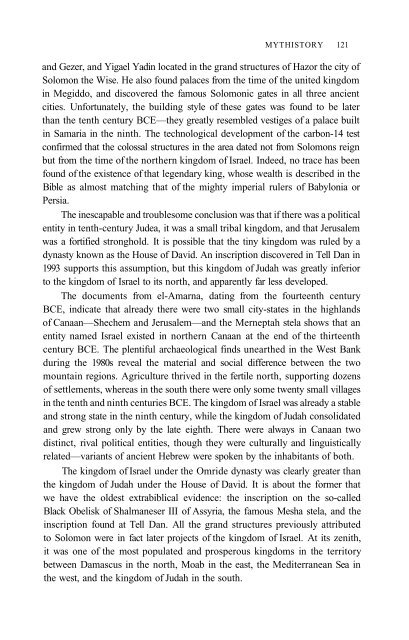Shlomo Sand, The Invention of the Jewish People - Rafapal
Shlomo Sand, The Invention of the Jewish People - Rafapal
Shlomo Sand, The Invention of the Jewish People - Rafapal
Create successful ePaper yourself
Turn your PDF publications into a flip-book with our unique Google optimized e-Paper software.
MYTHISTORY 121<br />
and Gezer, and Yigael Yadin located in <strong>the</strong> grand structures <strong>of</strong> Hazor <strong>the</strong> city <strong>of</strong><br />
Solomon <strong>the</strong> Wise. He also found palaces from <strong>the</strong> time <strong>of</strong> <strong>the</strong> united kingdom<br />
in Megiddo, and discovered <strong>the</strong> famous Solomonic gates in all three ancient<br />
cities. Unfortunately, <strong>the</strong> building style <strong>of</strong> <strong>the</strong>se gates was found to be later<br />
than <strong>the</strong> tenth century BCE—<strong>the</strong>y greatly resembled vestiges <strong>of</strong> a palace built<br />
in Samaria in <strong>the</strong> ninth. <strong>The</strong> technological development <strong>of</strong> <strong>the</strong> carbon-14 test<br />
confirmed that <strong>the</strong> colossal structures in <strong>the</strong> area dated not from Solomons reign<br />
but from <strong>the</strong> time <strong>of</strong> <strong>the</strong> nor<strong>the</strong>rn kingdom <strong>of</strong> Israel. Indeed, no trace has been<br />
found <strong>of</strong> <strong>the</strong> existence <strong>of</strong> that legendary king, whose wealth is described in <strong>the</strong><br />
Bible as almost matching that <strong>of</strong> <strong>the</strong> mighty imperial rulers <strong>of</strong> Babylonia or<br />
Persia.<br />
<strong>The</strong> inescapable and troublesome conclusion was that if <strong>the</strong>re was a political<br />
entity in tenth-century Judea, it was a small tribal kingdom, and that Jerusalem<br />
was a fortified stronghold. It is possible that <strong>the</strong> tiny kingdom was ruled by a<br />
dynasty known as <strong>the</strong> House <strong>of</strong> David. An inscription discovered in Tell Dan in<br />
1993 supports this assumption, but this kingdom <strong>of</strong> Judah was greatly inferior<br />
to <strong>the</strong> kingdom <strong>of</strong> Israel to its north, and apparently far less developed.<br />
<strong>The</strong> documents from el-Amarna, dating from <strong>the</strong> fourteenth century<br />
BCE, indicate that already <strong>the</strong>re were two small city-states in <strong>the</strong> highlands<br />
<strong>of</strong> Canaan—Shechem and Jerusalem—and <strong>the</strong> Merneptah stela shows that an<br />
entity named Israel existed in nor<strong>the</strong>rn Canaan at <strong>the</strong> end <strong>of</strong> <strong>the</strong> thirteenth<br />
century BCE. <strong>The</strong> plentiful archaeological finds unear<strong>the</strong>d in <strong>the</strong> West Bank<br />
during <strong>the</strong> 1980s reveal <strong>the</strong> material and social difference between <strong>the</strong> two<br />
mountain regions. Agriculture thrived in <strong>the</strong> fertile north, supporting dozens<br />
<strong>of</strong> settlements, whereas in <strong>the</strong> south <strong>the</strong>re were only some twenty small villages<br />
in <strong>the</strong> tenth and ninth centuries BCE. <strong>The</strong> kingdom <strong>of</strong> Israel was already a stable<br />
and strong state in <strong>the</strong> ninth century, while <strong>the</strong> kingdom <strong>of</strong> Judah consolidated<br />
and grew strong only by <strong>the</strong> late eighth. <strong>The</strong>re were always in Canaan two<br />
distinct, rival political entities, though <strong>the</strong>y were culturally and linguistically<br />
related—variants <strong>of</strong> ancient Hebrew were spoken by <strong>the</strong> inhabitants <strong>of</strong> both.<br />
<strong>The</strong> kingdom <strong>of</strong> Israel under <strong>the</strong> Omride dynasty was clearly greater than<br />
<strong>the</strong> kingdom <strong>of</strong> Judah under <strong>the</strong> House <strong>of</strong> David. It is about <strong>the</strong> former that<br />
we have <strong>the</strong> oldest extrabiblical evidence: <strong>the</strong> inscription on <strong>the</strong> so-called<br />
Black Obelisk <strong>of</strong> Shalmaneser III <strong>of</strong> Assyria, <strong>the</strong> famous Mesha stela, and <strong>the</strong><br />
inscription found at Tell Dan. All <strong>the</strong> grand structures previously attributed<br />
to Solomon were in fact later projects <strong>of</strong> <strong>the</strong> kingdom <strong>of</strong> Israel. At its zenith,<br />
it was one <strong>of</strong> <strong>the</strong> most populated and prosperous kingdoms in <strong>the</strong> territory<br />
between Damascus in <strong>the</strong> north, Moab in <strong>the</strong> east, <strong>the</strong> Mediterranean Sea in<br />
<strong>the</strong> west, and <strong>the</strong> kingdom <strong>of</strong> Judah in <strong>the</strong> south.




